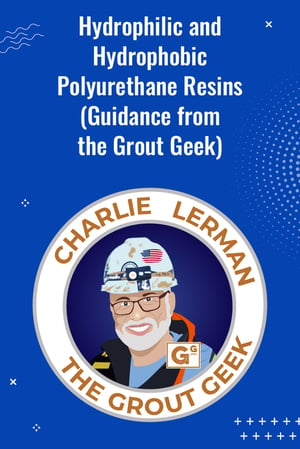
 Newcomers to urethane grouts often cut their teeth on these two terms, but the industry in general struggles with the understanding of what they are, and when to use hydrophobic vs. hydrophilic polyurethane grouts. So, I will cover the differences and then point out what I feel is a much more important conversation about polyurethane chemical grouts.
Newcomers to urethane grouts often cut their teeth on these two terms, but the industry in general struggles with the understanding of what they are, and when to use hydrophobic vs. hydrophilic polyurethane grouts. So, I will cover the differences and then point out what I feel is a much more important conversation about polyurethane chemical grouts.
Hydrophobic
- Cured States: Rigid, Semi-Rigid, Flexible Foam
- Reaction: Requires Water
- Requires Accelerator: Yes
- Elongation: None to 100%
- Wet/Dry Cycling: Unaffected
- Adhesive Bond: Good
- Pumped and Handles as: Single Component
Hydrophilic
- Cured States: Flexible Foam or Gel
- Reaction: Requires Water
- Requires Accelerator: No
- Elongation: None to 300%
- Wet/Dry Cycling: Can Dry Out
- Adhesive Bond: Superior
- Pumped and Handles as: Single Component
Somehow, the industry has erroneously assumed hydrophobic means: "fears water and pushes it away". While at the same time assuming hydrophilic means: "loves water and draws it in". There are some truths in these statements but they are only the core and are wrapped in misconceptions.
Misconception One: Water Loving and Water Fearing
Both grouts require water to activate and yes, the hydrophilic grout can incorporate more of the water into its cell structure, but both grouts will push water away when they have reacted with enough water to polymerize.
Misconception Two: Hydrophilic Grouts Dry Out and Shrink Without Water
A more accurate statement would be that cured hydrophilic urethane grouts can dry out and shrink in an arid environment. Concrete normally has a relative humidity of around 60% which will keep a hydrophilic foam hydrated. Soils can vary in their relative humidity but most often have enough moisture not only to keep a hydrophilic grout hydrated but also enough to polymerize a hydrophobic grout without the need for added water.
Misconception Three: Hydrophilic Grouts Have Better Adhesion
It is 100% true hydrophilic grouts have better adhesion in ASTM lab testing, and I did just list them as having superior adhesion. But, in my twenty-plus years in construction, I have never seen a grout job performed under laboratory conditions. Adhesion requires a clean surface for bonding. During crack injection, surface prep is a water flush in a crack we cannot see. So clearly it would be silly to believe we have a pristine surface inside the crack to adhere to. So yes, in a lab, hydrophilic grouts adhere to concrete better than hydrophobic grouts. In situ, both have a weak adhesive bond and both rely on their compressive and mechanical bonds much more than on an adhesive bond.
So, it's important to understand there is much more to grout selection than just hydrophilic and hydrophobic. I would estimate around 60% of chemical grouters only chemical grout a few times year. This can make product and methodology selection very difficult. That is why I am here with the Alchemy-Spetec team to help navigate you through these critical nuances. Call us at 404-618-0438 for technical assistance!


